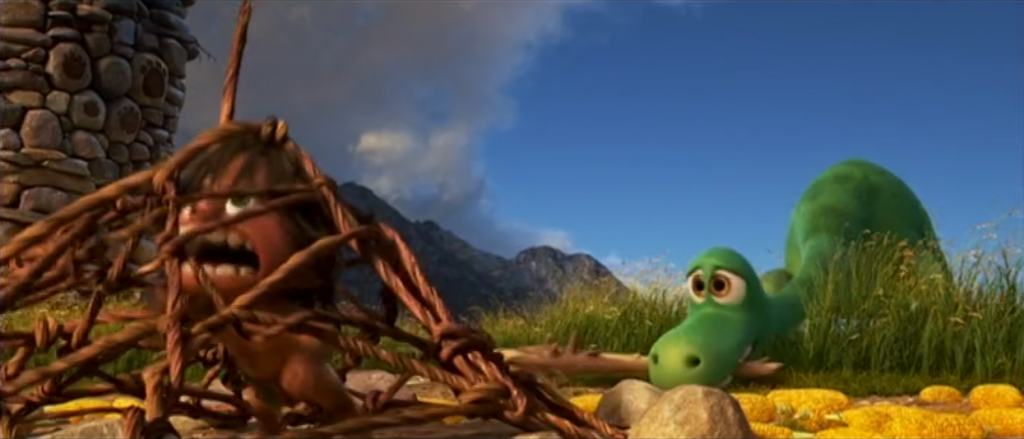Ever wondered what life would be like if dinosaurs never became extinct? Well, you’ll never have to wonder again thanks to The Good Dinosaur. In this alternate world human-animal relationships are reversed as the dinosaurs are civilised and positioned above humans hierarchically. In doing so, this film evokes questions surrounding the ethics of human practices such as hunting and trapping, alluding to the notion that animals and humans should coexist in a friendly world free of entrapment.
The human-animal relationship of trapping is subverted in this shot as the human boy is trapped by the dinosaur, whereas we would expect the animal to be trapped by the human. This subversion is emulated through a juxtaposition between the trapped and the free, with the dinosaur Arlo being afforded more agency than the human character Spot. Arlo’s freedom is shown through the mise-en-scene including grass and mountains in the background. This proves that the dinosaurs of this world are free to roam this mountainous area, with the presentation of sublime landscapes mirroring the natural habitats of wild animals featured in wildlife films such as The Bear (another film which criticises human hunting/trapping). Although, The Bear captures the beauty of the bear’s natural environment to criticise the invasion of humans into their world, whereas the landscapes in The Good Dinosaur reflect Arlo’s freedom which mirrors human agency.

Landscape in The Bear 
Landscape in The Good Dinosaur
However, Spot is given the opposite: a complete lack of freedom. Spot is positioned at the forefront of the shot, demanding the viewer to engage with the image of him in the trap. The hunting of him is shown through the mise-en-scene as there is a rope which is fixed to the ground with stones and corn on the floor. This alludes to how animals are captured by being lured in with bait and then trapped, with the spiky stick that Arlo possesses foreshadowing a painful murder. The inclusion of these objects within the scene heightens the vulnerability of the human character Spot. In turn, this evokes sympathy from the audience towards animals who are involved in the human-animal relationship of hunting.

Whilst hunting is a theme that is widely covered in films which also aim to give children a moral education against animal violence, the satirical twist which places animals as having human agency sets The Good Dinosaur apart from other films. Through employing this subversion, this film heightens the empathy that children will have when watching it as the character is a human like they are. This makes the audience consider the practice of hunting as unnecessary and harmful as they are able to resonate with the character Spot and recognise how distressed he is.

However, despite Arlo showing similarities to the role of humans in the human-animal relationship of trapping/hunting through his freedom and setting up the trap, he differs in his motivation for such actions. Arlo’s true motives are present within the mise-en-scene, as the footprints marked on the brick food container reveal his desire to ‘make his mark’ by protecting the farm like his other family members. Arlo achieves this not through brutally killing Spot in this trapping, but through his journey of self-discovery. By not resorting to such cruel actions of eating the human or abusing him, the animal is represented as having better morals than human hunters/trappers.
References:
Annaud, Jean, J. dir., The Bear (Price Entertainment, 1988)
Groening, Matt, dir., The Simpsons (20th Century Fox, 2003)
Sohn, Peter, dir., The Good Dinosaur (Disney Pixar, 2015)
